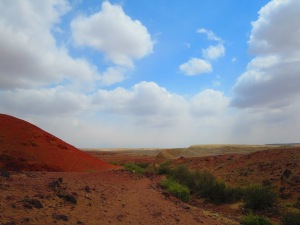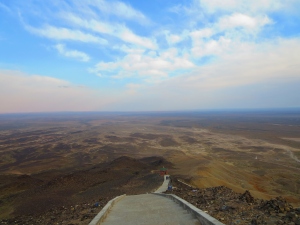Sainshand, The East Gobi

After a nighttime train ride with little sleep, my friends and I arrived at the Sainshand train station around 1 am. (A short stop along the Trans Siberian railroad, the arrival and departure times here aren’t always convenient.) With the help of our Mongolian friends, one of whom also works as a guide, we rendezvoused with our driver. The stout baseball-cap wearing Mongol drove us the roughly 30 kilometers from the capital “city” of Dornogovi province to Khamariin Khiid, a series of restored Buddhist monasteries in the vast desert of the East Gobi.
Exhausted from the noisy train ride filled with activity from exuberant children, drunk men, and amorous middle-aged couples in the public berths, we rested for two hours in a toasty ger, or yurt, with a roaring fire in the central stove. We awoke to our alarms just before daybreak and searched for our guide to take us to “wishing mountain” nearby, the must-see spot to see the sunrise. Due to our guide being nowhere in sight and refusing to answer phone calls, we marched out into the freezing windy desert and headed east towards to find our own view. And, slightly disappointed but still cheery, a view we found!
After catching some rays of sunlight, we walked back to the ger where we slept for a couple hours, breakfasted on snacks and coffee we brought, and embarked on our day tour with our slightly sheepish guide (who may have slept through his alarm and our calls!)

The sight of the first Mongolian theater, planned for reconstruction, and home of famous nineteenth century playwright and lama, Danzanravjaa.
However, the tour was worth it! While our guide didn’t speak English, our friends translated for us, revealing he was very knowledgeable!

A famous shrine, this nearby monument is especially important for women hoping to become or those already pregnant. This double stupa is intentionally shaped liked gigantic breasts and has been entirely covered in layers of dairy products and vodka. Women make offerings of milk in the windy morning.

As you can tell from the large puddle of milk, there were a LOT of women who came to pay their respects that morning. Men are encouraged to circle the shrine three times, but are not allowed to make offerings.

This road connecting various remote sights in the East Gobi was reportedly funded by the United States government as part of a Millennium Challenge Account project, a product of the United Nation’s Millennium Development Goals. It’s made tourism much easier and more comfortable!

The next stop on our Khamariin Khiid tour: a bell renowned for calling good spirits and energy to the ringers.

The best spot for receiving the energy is inside the bell. At first I thought these men were just messing around, but it’s a common ritual!
Perhaps the biggest attraction at Khamariin Khiid is a few kilometers down the smooth newly paved road: Shambhala, one of the world’s most-powerful energy centers. Discovered by monks centuries ago as a site favorable for advancing one’s meditation (and even reaching Enlightenment!) the rectangular park is bordered by stupas and crisscrossed by lines of triangular prayer flags.

A lion watches guard over the famous clay yard. Hundreds of tourists flocked to the site over our weekend, despite its remote location!

The view of Shambhala from the far Western edge of the enclosure. A woman approaches the main shrine from the incense offering.

The main shrine. Mongolians gather to sing a sacred incantation carved into a monument nearby and make offerings of vodka, candy, and milk.

Laying on their backs, Mongolians soak up the natural healthful energy believed to be emanating from the earth itself. I tried it too!

The name “Shambhala” has several layers of meaning. In Tibetan Buddhism and Hinduism, it’s a famous historical (or mythical) kingdom in inner Asia, made popular by the Kalachakra Tantra and the Vishnu Purana. It’s also known as a “Pure Land,” a heaven on earth where all who seek spiritual attainment shall find it.
After Shambhala, our guide took us to see the nearby meditation caves where monks and lamas were bricked inside for a total of 108 days while meditating. For the first 54, they received a small bowl of food through a single-brick opening. Every day they ground down the bowl three times until it completely crumbled and was useless. At that point, the small opening was sealed and the last 54 days were spent in complete darkness and isolation — without food! After that period, his fellow monks then tore down the wall. If he survived, he was granted a special spiritual status.

A Buddha statue now sits cross-legged where once a meditator did. Incense and offerings are commonly presented.

A tight squeeze; a “birthing canal” through which visitors crawl and are “reborn.” Those who crawl through before and after you are believed to be one’s spiritual brothers and sisters!
After exploring the caves it was time to return to the ger camp for lunch of buuz, steamed dumplings, with milky tea!

A stupa coin vending machine! What?! For a mere 5,000 tugriks your donation can yield a miraculous collector’s item! (Unless the machine eats your money and a monk needs to unplug and re-plug it in for you first…)
After visiting the monasteries and main stupa our group departed for wishing mountain (9 hours after our promised sunrise visit…)

Advertisements in front of wishing mountain! The commercialization of this area is amazing. Since my first visit here three years ago it’s remarkable how much things have changed!

In Mongolia, where there is a horse there is often a herder nearby. Not sure if this is the case here…

Wishing mountain! On the main “mountain,” or hill, only males are allowed at the top. Women and girls must stay at the first lower summit on the right.

Near the base of the mountain, people write wishes on pieces of paper and burn them in this incense burner in hopes that they will come true! I saw one woman with several full pages of handwriting. She must have had a life-plan!
After a very busy day at Kharamiin Khiid and the nearby attractions, we returned to the main city of Sainshand to the Danzanravjaa Museum, dedicated to the famous poet, playwright, and lama from Dornogovi province. With personal, religious, and literary artifacts, this museum is a treasure trove of culturally significant items.
We were lucky enough to overlap with a mutual friend of ours, Zahariz Khuzaimah, a well-known National Geographic photographer, documentary film-maker, and adventure touring cyclist.
Although we were totally spent after hardly any sleep and a cold windy day of sightseeing, our group greatly enjoyed chatting with Zahariz about his own adventures. He was planning to bike to the nearby Chinese border in the coming days. Check out one of his websites here. Quite the photographer!
http://www.malaysiannomad.com/
After dinner our group took the overnight train AGAIN, this time back to Ulaanbaatar. After all the excitement, I slept like a log! While I would recommend staying in a ger overnight to other visitors, the trip was phenomenal!

























Awesome. Great pictures with historical narration. You are really getting good at this.
Hi Eric! Thanks a lot! Can’t wait to catch up in person and chow down on some good ole American riiibz!
What a wonderful year and you have captured so many different facets of Mongolian life and culture. It has been great to follow you throughout this year. Looking forward to “the book.” Safe Travels.
Hi Elisabeth! Thanks so much for all the support! Glad you’ve been following along. Looking forward to writing it as well! I hope it will be a good way to reflect on and process my experiences in addition to sharing some of my favorite memories and (maybe even knowledge!)
Hello, we just found we can stop in this town in our way from China to Ulan Bataar, it would be useful for us if you please tell us, do you recommend to stop here? and did you stop at Chori too?
also, can you tell us the prices you paid for the tours or driving? Also, what month did you go? seems to be cold.
Thanks!
Hi! I would recommend staying in Sainshand! Amazing views of the Gobi. Energy center, caves, restored temples. Stay in a ger if you can -really any time of year it can be very cold. We went in May and it was snowing and extremely windy.There are plenty available gers near the main temple. We paid roughly 80,000 MNT for the day for a driver/guide but we had a Mongolian friend from Ulanbaatar translate for free. It would be great to get an English-speaking guide to really appreciate the sights more! It shouldn’t be too hard to find one once you’re there. You’ll just will need to ask around. Highly recommend watching the sunrise from Wishing Mountain if you can arrange it. Good luck! http://www.lonelyplanet.com/mongolia/the-gobi/sainshand
Thanks, we finally went to Sainshand, we just got off the train there at 1 am and found a cheap hotel, next day we walked from the train station to the city, nice walk for the 1st day in Mongolia, and after that, desert, temples, wild camels, etc etc, very nice day.
So glad you’re enjoying your time there! Depending on who long you stay, check out the Danzan Ravjaa Museum and try to get to the Wishing Mountain at sunrise! Glad you rode some camels too.